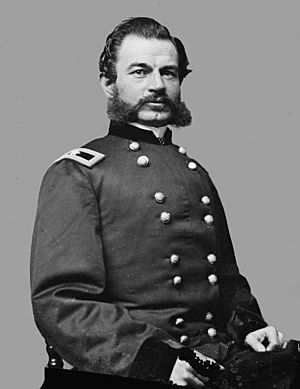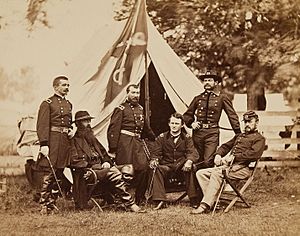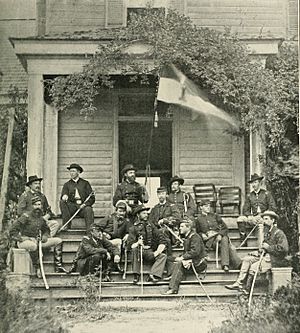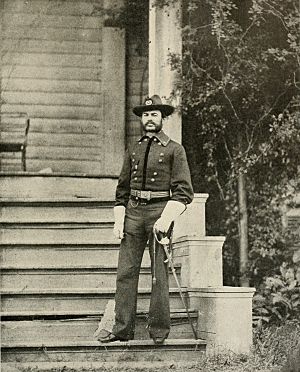Alfred Thomas Archimedes Torbert facts for kids
Quick facts for kids
Alfred Thomas Archimedes Torbert
|
|
|---|---|

General Alfred Thomas Torbert
|
|
| Born | July 1, 1833 Georgetown, Delaware |
| Died | August 29, 1880 (aged 47) Atlantic Ocean (off Cape Canaveral, Florida) |
| Place of burial |
Avenue Methodist Episcopal Cemetery, Milford, Delaware
|
| Allegiance | United States of America Union |
| Service/ |
United States Army Union Army |
| Years of service | 1855–1866 |
| Rank | |
| Commands held | 1st New Jersey Volunteer Infantry First New Jersey Brigade |
| Battles/wars | American Civil War |
Alfred Thomas Archimedes Torbert (born July 1, 1833 – died August 29, 1880) was an important American soldier and diplomat. He served as a general in the Union Army during the American Civil War. He led both foot soldiers (infantry) and horse soldiers (cavalry). After the war, he worked as a diplomat for the United States.
Contents
Early Life and Training
Alfred Torbert was born in Georgetown, Delaware. He chose to pursue a military career. He attended the United States Military Academy at West Point. This is a famous school for training army officers. He graduated in 1855, ranking 21st in his class. After graduating, he became a second lieutenant in the 2nd U.S. Infantry Regiment. His roommate at West Point was William B. Hazen, who also became a general.
Serving in the Civil War

When the Civil War began, Torbert was offered a position in the Confederate Army. However, he chose to stay with the U.S. Army. By September 1861, he became a colonel, leading the 1st New Jersey Infantry. In August 1862, he was put in charge of a brigade. A brigade is a large group of soldiers.
During the Maryland Campaign in 1862, he was wounded at the Battle of South Mountain. He was promoted to brigadier general in November 1862. A brigadier general is a high-ranking officer. Torbert led his New Jersey brigade in several major battles. These included the Battle of Fredericksburg, the Battle of Chancellorsville, and the Battle of Gettysburg.
Leading Cavalry Forces
In April 1864, Torbert was given command of the 1st Division of the Cavalry Corps. This meant he was in charge of many horse soldiers. He led them during the Overland Campaign. He also served as the Chief of Cavalry for the Army of the Shenandoah. This was under the command of Major General Philip Sheridan. Torbert led cavalry in important battles like the Battle of Third Winchester and the Battle of Cedar Creek.
His last campaign as cavalry chief was a raid in December 1864. This raid was near Gordonsville, Virginia. The weather was very bad, with intense cold, rain, and snow. Many of Torbert's men suffered from frostbite. After this difficult raid, Torbert took a long leave of absence.
General Sheridan lost some confidence in Torbert after the Gordonsville raid. In March 1865, Torbert was ordered to stay in the Shenandoah Valley. This was when Sheridan moved his main forces to Petersburg, Virginia. Torbert commanded the remaining Army of the Shenandoah until July 1865.
Torbert received special "brevet" promotions for his service. These were honorary promotions for his bravery and success. He was recognized for his actions at Gettysburg, Haw's Shop, Third Winchester, and Cedar Creek. He was mustered out of volunteer service in January 1866. He then resigned from the Army in October 1866.
Life After the War
After the Civil War, Alfred Torbert became a diplomat. A diplomat represents their country in other nations. He served as the U.S. Consul to El Salvador in 1869. Later, he became the U.S. Consul General in Havana in 1871. In 1873, he served as the U.S. Consul General in Paris, France.
Tragic End
On August 29, 1880, Torbert was traveling to Mexico by steamship. The ship was called the Vera Cruz. A powerful hurricane hit the ship off the coast of Florida. Torbert was washed overboard during the storm. Accounts say he made it to shore alive. This was more than 20 hours after the ship sank. However, he sadly drowned in the ocean waves shortly after reaching land.
His body was found two days later. He was first buried in Daytona Beach, Florida. Later, his body was moved to New York City, then Philadelphia. Finally, he was laid to rest in the Avenue Methodist Episcopal Cemetery in Milford, Delaware. Military units escorted his body along the way. Many people attended memorial services in his honor. Government officials and foreign dignitaries paid their respects.
In Memoriam
In 2008, a statue honoring General Torbert was put up in Milford, Delaware.
See also
 In Spanish: Alfred Thomas Torbert para niños
In Spanish: Alfred Thomas Torbert para niños



